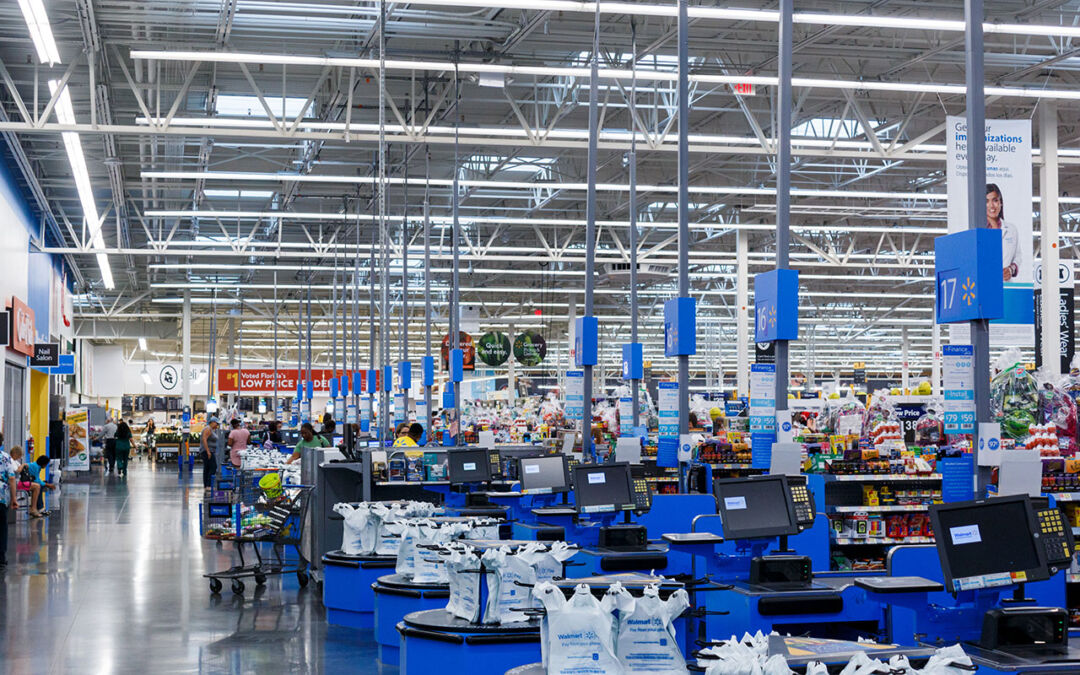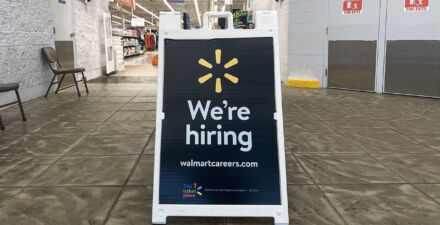Walmart is a monopsonist that depresses earnings and employment beyond its own walls, but U.S. policymakers can do something about it

Overview
Labor income inequality is a major cause for concern in the U.S. economy. For 35 years beginning around 1980 the wages of workers steadily grew more and more unequal. This has been variously attributed to several factors—including technological change that shifted the demand for labor away from “middle-”educated workers, the growing adoption of industrial robots, U.S. workers’ exposure to international trade amid rising globalization, the declining real value of the minimum wage (especially in the 1980s and particularly for women), and declining unionization rates.
But many economists also believe employer monopsony power contributes to labor income inequality. Put simply, monopsony power is the ability of an employer to set wages below the level that would hold if the labor market were competitive, or “free.” This wage-setting power can stem from, among other channels, collusive behavior among employers, excessive costs for workers to access jobs or find new ones, and reduced competition in the labor market resulting from competitive frictions in other markets.
London School of Economics professor Alan Manning has argued that the source of all these tributaries is essentially labor market “thin”-ness or “employer concentration.” Manning and other economists find that increased local monopsony power reduces wages, especially at the lower end of the income distribution. But there is still debate over the degree to which monopsony power may be responsible for aggregate labor income inequality.
Economist Anna Stansbury at the Massachusetts Institute of Technology’s Sloan School of Management and her co-authors, for example, find that the wages of nearly 12 percent of workers in the United States are substantially suppressed by employer concentration. The majority of workers, however, are not in highly concentrated labor markets.
Similarly, Kevin Rinz at the U.S. Census Bureau concludes that local labor market concentration has not been a major contributor to growth in aggregate labor income inequality because he finds average local labor market concentration has fallen since the mid-1970s. Importantly, however, he estimates sharp increases in both national and average local labor market concentration in the retail trade industry.
Another conclusion is possible. If growing local monopsony power in the retail sector pushed local wage floors downward, with spillovers on workers in other local industries, then the role of monopsony power on aggregate labor income inequality may be substantial.
In my working paper, “Walmart Supercenters and Monopsony Power: How a Large, Low-Wage Employer Impacts Local Labor Markets,” I provide evidence that Walmart Inc.—the largest private-sector employer in the United States—exercised monopsony power in labor markets where the firm opened Supercenter stores, with consequences well beyond the retail sector. Specifically, I demonstrate that local Supercenter entry reduced countywide aggregate employment and earnings while an increase in the minimum wage caused local aggregate and retail employment to increase in counties that had a Supercenter. These results run contrary to what economists would expect if labor markets were competitive.
In this issue brief, I provide some context for thinking about the role that Walmart Supercenters play in local labor markets in the United States before outlining the novel approach I use to estimate their impact on several outcomes of interest. My results provide the backdrop for a discussion of how this retail giant and other large, low-wage employers may gain the ability to exercise monopsony power. These findings have significant implications for potential policy responses when labor markets are not competitive.
I conclude the issue brief with four possible policy responses based on the findings in my working paper. I argue that policymakers should:
- Preemptively support collective bargaining and higher local minimum wages in communities where employers may have the opportunity to exercise monopsony power
- Prescriptively support collective bargaining and higher local minimum wages in communities where employers are already exercising monopsony power
- Examine the wage- and price-setting powers of monopsony employers when considering policy decisions
- Examine the monopsony power of employers in local labor markets, especially at the low end of the wage scale, when making policy decisions
Walmart Supercenters and local labor markets
After decades of growth and success selling discounted general merchandise, in 1988, Walmart opened the doors of its first Supercenter. By the end of 2005, nearly 2,000 of these Supercenters had opened in more than 1,200 counties across the United States. This rapid growth continued for another decade, with more than 3,400 Supercenters nationwide opening by the beginning of 2015.
Between two and four times the square-footage of the firm’s older, discount store format, which had largely sold general merchandise, the new Supercenters offered many services outside the retail archetype of the day, such as photo processing, tire and lube sales and service, and financial services, as well as an expansive selection of general merchandise and full-service grocery options at substantially lower prices worth 3 percent of average annual household income. Many stayed open 24 hours per day.
A typical Supercenter employed between 350 and 475 people—a very large share of whom were women. Moreover, with firmwide annual employee turnover around 70 percent—almost certainly concentrated among the firm’s sales staff—most Supercenter workers needed to be replaced each year. According to data that Walmart was compelled to submit to a court in 2002, the company had nearly 4 million unique U.S. employee records from January 1996 through March 2002. During this period, Walmart’s U.S. employment increased from around 620,000 employees to around 1.1 million.
In other words. Walmart had to hire nearly 4 million workers over that 6-year period alone to help increase the size of its workforce by 1 million employees between 1990 and 2005. And despite the high employee turnover, Walmart was able to keep average wages and benefits very low, even for the retail sector. This, in turn, helped to boost real annual profits by more than 500 percent over the same time period.
Walmart currently guarantees its workers a minimum starting wage of $12 per hour. In contrast, rival big retailers Amazon.com Inc. and Target Corp. guarantee their workers a minimum of $15 per hour, while Costco Wholesale Corp. pays new workers at least $16 per hour. But Walmart can reduce the local wage standard. In 2003, for example, in anticipation of the impending rollout of Walmart Supercenters across California, incumbent California grocery chains cited Walmart’s low labor costs as a factor behind their attempt to cut employee benefits and wages for new hires, resulting in a months-long strike of nearly 70,000 grocery workers.
How to estimate the local U.S. labor market impact of Walmart Supercenters
Because of Walmart’s apparent downward pressure on local retail-sector compensation amid its rapid expansion over the past four decades, many observers have made a lot of (mostly negative) claims about Walmart’s local impact. The U.S. House Representatives’ Education and Labor Committee even issued a report on Walmart’s cost to taxpayers. Yet from a research perspective, it is very difficult to actually identify whether Walmart caused these local outcomes or whether they could be the result of another simultaneous phenomenon in the local economies where a Walmart opened.
In an economist’s ideal research environment, we would study two identical universes where everything was the exact same until we interfered—much as in an ideal scientific experiment, where we could perfectly control everything that was different between them. We could pick one universe at random in which we would “treat” communities by opening Walmart Supercenters in them, and we would then compare the outcomes in the treated places to those in their otherwise-identical “control” communities in the other universe. The difference in outcomes in any treated-control community pair would be the “treatment effect” in that community.
Sadly for economists—but in a win for everyone else—we do not wield this sort of power over the multiverse. The best we might hope for is a randomized control trial in which we could randomly assign some places in our universe to get a Walmart Supercenter and others in the same universe to not get a Supercenter. We would observe and control for any remaining arbitrary differences between the places. And then, we would compare outcomes of interest, such as employment and earnings, to estimate the treatment effects of entry.
The real world where Walmart operates is much messier. It is extremely difficult to estimate any unbiased causal treatment effects of Supercenter entry into a community even if economists observe outcomes of interest in treated communities for several years before and after Walmart opened Supercenters, even if we observe the same in several control communities where Walmart didn’t open these stores, and even if we also observe what we think are important control variables in all these communities.
This is because any estimated effects may still be contaminated by bias from what economists call “endogenous entry”—that is, from “endogeneity bias,” meaning there may have been some unknown reason or reasons correlated with outcomes we’re interested in, such as employment or earnings, which motivated Walmart to choose to open Supercenters in some communities at the times that it did, but not in those places it didn’t.
The upshot: Our outcomes of interest were already going to evolve differently in the two types of communities even after controlling for observable differences. In the absence of any further efforts, we can’t differentiate the impact of Supercenter entry on any outcome of interest from those changes that stem from unobserved differences among the two types of communities. Any resulting estimate of the treatment effects of entry could be really wrong or biased.
Several dueling papers that investigate Walmart’s local impact on employment or earnings make efforts to try to deal with this endogenous entry concern using a statistical technique called “instrumental variables estimation.” The validity of this approach essentially boils down to finding a new variable that is correlated with a Walmart entry but which otherwise is uncorrelated with the outcome after controlling for observables. The instrumental variables that these authors came up with are clever but, as they point out about each other’s instruments, may be invalid because they probably fail to meet this full test of validity. As a result, their estimates may still be contaminated by endogeneity bias—which may explain why they ended up with very different results.
To address this potentially serious endogeneity issue, I take a different approach in my recent working paper. I begin by collecting observations over the period 1990–2005 on 39 counties where Walmart tried to build a first Supercenter but where local efforts prevented them from successfully doing so. To do this, I collected anecdotal observations of frustrated efforts to open Supercenters from the anti-development Sprawl-Busters Newsflash Blog, which posts thousands of rumors and reports of possible local Supercenter entries from citizens in communities all over the United States.
I then culled this list to the counties where, using local news reports and council minutes, I could confirm that Walmart did demonstrate a significant interest in building a Supercenter, and I cross-referenced these with data on counties and dates of Supercenter entry to ensure that no Supercenter was built in these control counties before the final months of 2005. Selecting the “donor pool” of control counties in this way means that they are much more likely than other untreated counties to share those unobserved features and trends that Walmart used to select counties where it successfully opened a Supercenter. Why? Because Walmart wanted to enter these donor pool counties, too.
I show that selecting the donor pool counties in this way makes them highly similar to the treated counties on those variables that I can observe and which might have influenced Walmart’s entry decisions. The treated counties that Walmart did enter are much more similar to these donor pool counties than they are to the remaining untreated counties, where Walmart did not try to build a Supercenter and are not in the donor pool.
Armed with these data and annual county-level observations of labor market outcomes from several sources—including county-by-industry observations from the Quarterly Census of Employment and Wages compiled by the U.S. Bureau of Labor Statistics, fed by data from state Unemployment Insurance reporting systems—I then estimate a “synthetic control” for each treated county that got its first Walmart Supercenter and was observed for at least 5 years before and after entry during this period. This synthetic control estimator selects weights to best match the pre-treatment characteristics of each treated county to the untreated donor pool counties.
The result for each treated county is a “synthetic” version of itself that is a weighted average of a subset of the donor pool counties. Intuitively, a synthetic control that matches its treated equivalent very well in the pre-treatment period is a good approximation of that treated county in a parallel universe where it was never treated but is otherwise identical. The difference in the outcome between each treated county and its synthetic control is the estimate of the treatment effect from that ideal multiverse thought experiment.
With dynamic treatment effects estimated for each treated unit, I then “stack” these estimated effects in event time and average them. I also adopt several approaches to test whether the resulting estimates of the average treatment effects on the treated counties are larger than what we expect from random noise in the data. My findings are telling.
How Walmart Supercenters impact local labor markets
Use this estimation strategy, I find that the entry of Walmart Supercenters caused large declines in aggregate local employment, earnings, and labor force participation 5 years after entry. My results suggest that the median treated county had more than 600 fewer employed workers 5 years after Supercenter entry into a community, with many of these workers leaving the local labor force altogether.
Among those fewer workers who were employed 5 years after entry, their average annual earnings in the median treated county were about $750 less than before the entry of the Walmart Supercenter. Unsurprisingly, given the shock to local labor demand that the arrival of a Supercenter represents, I find that local retail employment and earnings jumped sharply in the year of entry as the Supercenters staffed up, but, by the fifth year after entry, both outcomes had largely regressed to their pre-entry values.
As would be expected, given these results, I find that Supercenter entry was responsible for a large increase in the low-wage retail sector’s share of local employment, alongside a sharp increase in employment concentration among local retail-sector firms, as seen in the monopsony literature described earlier. All of these results are most consistent with the conclusion that after the immediate positive shock to local labor demand that accompanied the opening of a Supercenter, Walmart quickly began displacing labor demand from incumbent retailers with whom it also competed for local market share.
As those incumbent retail employers began shedding workers, resulting in Supercenters capturing an increasing share of local low-wage job openings as Walmart replaced the 70 percent of workers it lost to attrition each year, the firm increasingly gained the ability to lower the wage rate it needed to offer in order to attract enough workers to staff their stores. This dynamic would have lowered the wage floor faced by local nonretail employers—even those with no wage-setting monopsony power—essentially lowering the prevailing wage that those employers would have to offer to attract new workers to low-wage positions.
If local nonretail employers were able to hire new workers at lower wages, and if retail employment didn’t fall below pre-entry levels, then why didn’t aggregate local employment increase instead of decreasing? To investigate this, I look separately at goods-producing and service-providing industries. I find that the same pattern of Supercenters causing sharp declines in employment and earnings in the aggregate is even more apparent when disaggregated in this way. But why would Supercenter entry negatively impact employment and earnings outside the retail sector? The explanation likely has to do with Walmart’s supply chains.
Walmart is well-known for pressing its suppliers to cut costs, which often results in consolidation that reduces wages and employment among their own workforces. A string of products and their suppliers caught in this vice include Coca Cola bottlers, Vlasic Pickles, Nabisco cookies and crackers, Dean Food products, Hoover and Maytag appliances, Huffy bikes, Dial soap, Levi Strauss apparel, Master Lock, and Eastman Kodak products and services.
To the extent that Supercenters source from local firms, these cost-squeezing practices would have contributed to my results and increased Walmart’s ability to set local wages. But Supercenters are largely supplied through Walmart’s network of distribution centers, which are often located counties or even states away and which themselves often source from a small number of factories located states away or even internationally.
A consequence of these supply chain dynamics is that, as Supercenters captured local retail market share, Walmart’s suppliers displaced the local producers who supplied incumbent local retailers, reducing the labor demand of these local producers and contributing to aggregate employment losses. This, again, would have made Supercenters responsible for an even larger share of local demand for less-skilled labor and further reinforced their ability to set wages, while also exacerbating any negative impact on local multiplier effects.
The findings in my working paper are not conclusive evidence that all of these dynamics were at play, yet the set of results for the separate industrial agglomerations certainly supports this explanation. Local goods-producing industries did experience sharp contractions in employment and earnings. Moreover, so did service-providing industries—suggesting that local service-providing suppliers of these incumbent local firms may have been further casualties in a cascading chain of effects.
This set of estimated effects of the entry of Supercenters into local U.S. labor markets is broadly consistent with these Supercenters gradually gaining and exercising monopsony power, with negative consequences for workers. Few, if any, other explanations fit the pattern of results.
Still, more evidence is always better. That’s why, in my working paper, I also test whether the monopsony power explanation is supported by the evidence when the treatment is different and should reduce the local impact of monopsony power. Specifically, and again using the synthetic control estimation strategy described earlier, I look at the local impact of the 1996–1997 federal minimum wage increase—plausibly exogenous to local economic conditions—in counties that already had a Supercenter. To do this, I restrict my treated and donor pool counties to those in states which tracked the federal minimum wage over this period. I find that the minimum wage increase sharply increased aggregate and retail employment in counties that had a Supercenter, while also increasing retail-sector earnings.
If local labor markets in those counties had been competitive, then a binding minimum wage increase should have had negative employment effects, if anything. These minimum wage results alone are highly indicative that Supercenters were exercising some degree of local monopsony power, with the minimum wage increase reducing Supercenters’ ability to set wages low, while increasing the number of local workers willing to work at the prevailing wage, helping to boost employment.
Taking my estimates of the effects of Supercenter entry together with my minimum wage results, the evidence strongly suggests that Walmart Supercenters exercised local monopsony power—at least over my period of study—with large spillovers even beyond the retail sector and with large, negative impacts on workers.
Certainly, the estimated effects of both treatments—along with the implication that Supercenters exercise a degree of monopsony power—are average results. Treatment effects are heterogeneous across counties, though not across cohorts. Restricting the treated and donor pool samples to only nonurban counties—where labor markets are thinner and monopsony power is more likely—generally yields even larger average effects. Still, the average effects, which are primarily from urban counties, are broadly significant and robust to several specifications and sample restrictions.
Implications and possible policy responses
What might these results imply for policymakers and researchers? And what policy responses might be appropriate and effective? I suggest four policy responses targeted at undermining firms’ ability to exercise monopsony power, with the goal of making affected labor markets more competitive. Policymakers should:
- Preemptively support collective bargaining and higher local minimum wages in communities where employers may have the opportunity to exercise monopsony power
- Prescriptively support collective bargaining and higher local minimum wages in communities where employers are already exercising monopsony power
- Examine the wage- and price-setting powers of monopsony employers when considering policy decisions
- Examine the monopsony power of employers in local labor markets, especially at the low end of the wage scale, when making policy decisions
Let’s consider each of these policy responses briefly in turn.
Preemptively support collective bargaining and higher local minimum wages
The estimates in my working paper are specific to Walmart Supercenters, yet the results are likely to hold more generally for large employers with low-wage business models that are active in thinner labor markets. Numerous such employers have operated in the United States in the past 40 years, and many are operating today.
This suggests that policymakers would do well to consider whether a local labor market is thick enough to absorb a new low-wage employer without it being able to exercise much monopsony power to the detriment of local workers. If not, then policies that support collective bargaining or set higher local minimum wages for employers of a certain size might be highly effective at preventing such employers from negatively impacting local labor markets.
Prescriptively support collective bargaining and higher local minimum wages
The results of my analysis of the impact of the 1996–1997 federal minimum wage increase in counties with a Supercenter suggest that in local labor markets that are already likely subject to monopsony power, a targeted minimum wage increase may help to counteract the negative effects and boost employment.
These findings also suggest that the discordant estimates of the employment effects of minimum wage increases that are found in the economic literature might be at least partially reconciled by accounting for local monopsony power. Note that my results do not imply that less-targeted minimum wage increases would be employment-boosting.
Examine the wage- and price-setting powers of monopsony employers when considering policy decisions
Economists and policymakers alike should not be quick to dismiss the consequences and costs of Supercenter monopsony power simply because consumers benefit from Walmart’s lower prices. Those lower prices are estimated elsewhere to be worth 3 percent of annual average family income for a household that buys all its groceries at Walmart, but I estimate total countywide earnings were more than 5 percent lower by the fifth year after Supercenter entry. This is an unfavorable comparison for Walmart’s prices even without considering that many families do not buy all, or even most, of their groceries from a Supercenter.
What’s more, in results not discussed above, I find that Supercenter entry was also responsible for substantial increases in local Earned Income Tax Credit receipts, which I estimate to have cost U.S. taxpayers more than $6.3 billion (in 2017 U.S. dollars) between 1995 and 2005 alone—despite the associated lower rates of labor force participation, earnings, and employment. Given this context, the increased EITC receipts seem likely to have been the result of workers becoming eligible for the EITC due to reduced earnings following the local entry of a Walmart Supercenter and may even have facilitated Supercenter monopsony power by partially “topping up” low wages. In the light of these results, Walmart’s lower prices seem underwhelming.
Examine the monopsony power of employers in local labor markets, especially at the low end of the wage scale, when making policy decisions
Given the ubiquity of Supercenters across the United States by the end of my study period in 2005 and the continued growth in their numbers through 2015, it is highly likely that a substantial and growing number of low-wage workers in the country were exposed to some degree of monopsony power exercised by a Supercenter during that period—even if many labor markets where Supercenters operated were thick enough to preclude much wage-setting ability. This rapid spread of Walmart Supercenters likely left very large numbers of low-wage workers earning wages well below what their employers may have been willing to pay them in competitive labor markets.
This may help explain why, despite wages growing so much more quickly at the bottom of the pay distribution than they did for everyone else between 2015 and 2020, bottom-quartile wages have had room to grow that much more quickly again during the past year. At the beginning of 2021, record numbers of workers began quitting their jobs—especially in the retail trade and leisure and hospitality sectors that have long offered by far the lowest average earnings of all nonfarm industries. The number of monthly job openings in these two sectors consequently shot up, which soon led employers to raise wages in an effort to attract new staff. As a result, between December 2019 and December 2021, average hourly earnings grew more quickly in these two lowest-wage sectors than in any other U.S. sector, despite no obvious increase in labor productivity.
If average wages in these two industries had been even close to the levels that would have prevailed if low-wage labor markets had been broadly competitive, then we should not see job openings remaining near record highs alongside such disproportionately high average wage growth even as employment levels recover. The strong implication is that many low-wage workers were long subjected to less-than-competitive wages due to monopsony power that has only been counteracted by incredibly tight labor markets.
Given all of this, it is not unlikely that monopsony power exercised by Supercenters played some role in growing labor income inequality through 2015. While my paper does not attempt to estimate any distributional effects of Supercenters, this is a promising area for further research that could be highly complementary to the existing inequality literature and could help inform policymakers in their policy choices to corral the monopsony power of employers in local labor markets.
Conclusion
There is substantial evidence that Walmart Inc., the largest private-sector employer in the United States, exercises monopsony power. This has had large, negative consequences well beyond its stores’ walls, causing substantial decreases in local employment, earnings, and labor force participation, as well as higher public spending. The labor market effects were large and widespread enough that they may also have contributed to growing labor income inequality over the past four decades—though this is less clear.
The evidence also suggests that these consequences can be at least partially mitigated, and local employment boosted, by increasing minimum wages in local labor markets affected by monopsony power—though this should not be taken to suggest that more broadly applied minimum wage increases will similarly boost employment in places that are not clearly affected by monopsony power. To the extent possible, however, policymakers might do better by preventing new large, low-wage employers from being able to exercise monopsony power in the first place, through policies that support collective bargaining or set higher local minimum wages for larger employers.
Common-sense use of policies such as these can help undermine the ability of large, low-wage firms to exercise monopsony power and can move affected labor markets closer to what they might look like if they were truly free and competitive.
— Justin C. Wiltshire is a Ph.D. candidate in economics at the University of California, Davis. Beginning in September 2022, he will be a postdoctoral scholar at the Institute for Research on Labor and Employment at the University of California, Berkeley. Beginning in 2023, he will be a lecturer (assistant professor) in economics at the University of Queensland. His research explores how regional economies evolve and how less-advantaged workers fare, with an eye on the interplay between local labor market power, institutions, and local prices.





